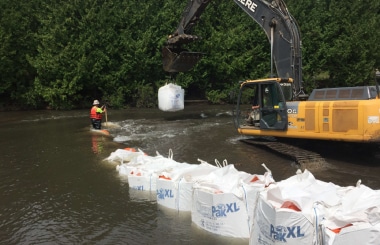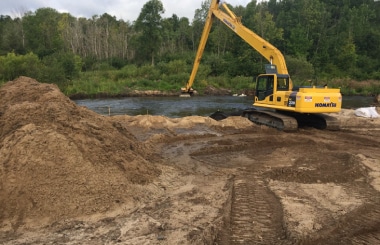What nearby communities can expect when a dam comes out of a river
Every dam removal is unique, but there are general similarities in every project. Each project usually requires years of preparation for the specific circumstances of the surrounding area, characteristics of the impoundment and sediments, and special consideration of the dam age, materials, and condition.
Dam removals can be complicated and often involve many construction aspects proceeding simultaneously, that require the work of many experts from many fields. The entire process takes years of planning, investigation, analysis and engineering, and years of river restoration post dam removal. The actual deconstruction of the dam is a relatively short component of the whole process, but reshaping a natural river channel where there once was an artificial lake can take a year or more of active construction work for medium or large dams.
There are many steps that need to be completed before the actual deconstruction of the dam. The entire affected area must be carefully assessed beforehand. These investigations include topographic and bathymetric surveys (to map the depths and shapes of underwater land), sediment sampling to characterize sediment quality and type, sediment probing to determine sediment quantity, habitat assessments for threatened and endangered species, land surveys to determine ownership of the bottom lands, and geotechnical and structural data collection for engineers to assess the existing conditions at the dam. Survey teams map out the impoundment and downstream sections of the river to determine project tie in locations. Detailed hydraulic modeling is required to assess dam removal impacts to water surface elevations within the project area. This hydraulic modeling will also assess any attenuating effect the existing dam has on flood flows and will model expected changes to the river channel.
Safely Managing Sediment is a Key to All Dam Removal Projects
The quality and quantity of sediment trapped above the dam in the artificial lake or pond, known as an impoundment, often determines the method for dam removal and can significantly impact the cost of dam removal and the associated river restoration. For this reason, sediment data collection is a key aspect to all dam removal projects. The sediment characterization data and estimated quantities of impounded sediment tells us what we can and cannot do with the sediment, either by manually removing it from the river channel, or by letting the restored, flowing river naturally displace it downstream.
Brendan Cousino of LimnoTech previously talked about the sediment data collection process in the Pen Dam impoundment in this video.
Once the design team understands the sediment characterization (determining whether the sediment is clean or contaminated), a sediment management and dewatering plan can be developed in conjunction with the dam removal plans. These plans typically go through multiple stages of detailed design – preliminary, draft, and final designs which are reviewed at each stage by technical experts, project stakeholders, and regulators. These plans are then used to develop the required state and federal permit applications. Once the design has been finalized and permit applications have made it through the regulatory process of reviews and public notice periods, the dam removal design can be finalized and the project issued for contractor bids and ultimately construction and actual dam removal.
Removing a Dam is a Slow, Careful Incremental Process
There are many misconceptions about the actual deconstruction, or demolition, of dams. First, dam removal is intended to be a slow, incremental, process. The water must be released very slowly, typically dropping only six inches per day, at most. To people downstream in the river, the additional flow is largely negligible, but may look like a higher flow typically seen following a heavy rainstorm.
Another common misconception is that the dam is suddenly blown up or knocked down. That is never the case in an urban setting and is rarely the case anywhere for medium or large dams. The dam is removed piece by piece from top to bottom over weeks or months, often after much of the water has been drained from the impoundment.
What Will the Removal of Pen Dam Look Like
Based on past experiences with similar dams, we can anticipate what a dam removal might look like in a specific case. Right now, we’re working to remove Peninsular Paper Dam in Ypsilanti, known as Pen Dam. Pen Dam is a concrete spillway across a broad section of the Huron River and stands about 15 feet high. There are removable stoplogs at one end of the dam (Photo 1).
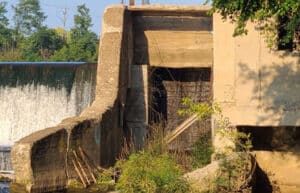
We might be able to remove these logs one at a time from the top to let water drain downriver, slowly lowering the water surface upstream of the dam. We might also be able to incrementally chip away at the concrete crest of the dam, cutting a river channel sized notch in the dam, a few inches lower each day to lower the water upstream of the dam. A series of photos illustrating this process is provided below. Most likely, the dewatering operation will utilize both strategies. First, removing the stoplogs to initiate the dewatering and then move to a combination of passing river flow through the stoplog structure as well as incrementally demolishing a section of the concrete weir crest.
Incremental dewatering through an existing concrete dam. (Photos courtesy of AECOM) Photos 2-8:
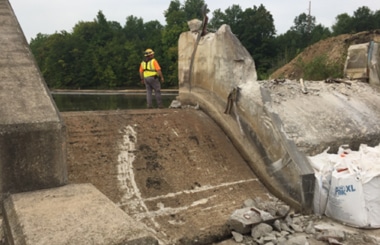 |
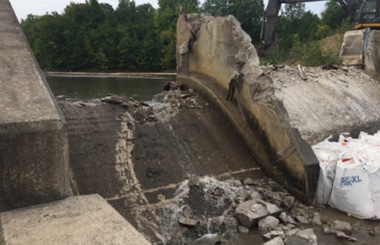 |
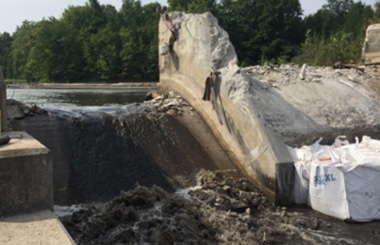 |
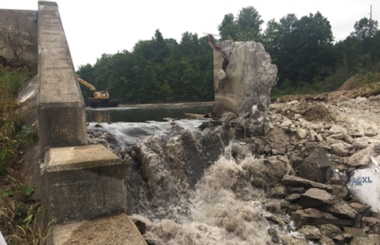 |
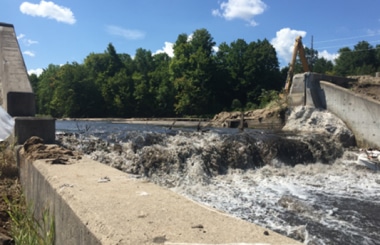 |
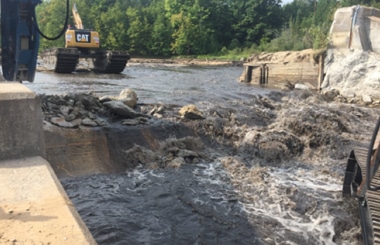 |
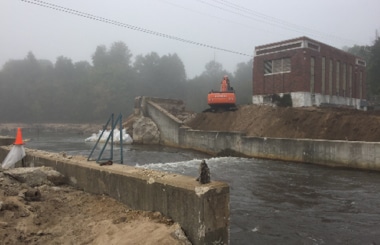 |
Construction Work Sometimes Requires Special Equipment and Procedures
Once the impoundment has been fully dewatered and the water level above the dam approximately matches the water level downstream, any remaining concrete structures of the dam can be removed. In the case of Pen Dam, this will probably include all the heavy equipment you’d normally see at a construction site for removing concrete or the foundations of old buildings. The major difference, of course, is that the work is being done in a river, which requires additional planning and safety precautions. Some contractors have access to amphibious excavators which are excavators that can float and move on the water. These are specialty pieces of equipment that can help the contractor access hard to reach locations within the flowing river. It is possible this type of equipment could be used to remove Pen Dam.
Sediment Management is a Constant Focus
Before, during, and for some time after the dam removal, sediment will need to be managed. The goal of managing sediment is to minimize the transport of sediment downstream. Rivers normally move a lot of sediment, but a dam causes sediment to build up unnaturally. When removing the dam, we want to avoid surges of sediment moving downstream. We also want to prevent erosion along the banks of the river. The water level will drop, and in places, the river will move faster than it once did. Faster moving water can scour banks of sediment. The dewatering and dam removal process needs to be intricately tied with the project’s sediment management plan. Sediment moves as the water level upstream of the dam is lowered. The contractor will be able to manage a large portion of the moving sediment by slowing the dewatering rate and actively managing sediment within the impoundment.
Cloudy Water During Removal is Common
Even following best practices, visitors to the river during and immediately after a dam removal should expect to see turbid, cloudy, black or dark brown water. We expect this, because the finest particles of sediment – the silts and fines— are very difficult to capture. Turbidity within the river will be minimized to the extent practicable and will have minimal long-term effect on wildlife and habitat. Most of the sediment, the sand and larger –grain size material, will be captured through active and passive management within the project area, but the finest particles will result in noticeable cloudy water through the project area and downstream. This will be most noticeable during active dewatering and construction work within the river which, for the removal of Pen Dam, could take up to 6 months or more. Once the dam is removed and a new river channel is established, the turbidity will decrease and return to existing conditions.
Sediment Traps May Be Used
Sediment traps are a common way to passively manage sediment within the impoundment and immediately downstream of a dam removal. One way to construct these is by building deeper pools of water within the river using sandbags that slow the flow of the river and allow the sediment to fall out of the water column (Photo 9). This is considered a passive management approach because it gives the river time to move material as it would have naturally if the dam had never existed, but still allows a capture mechanism. These structures require the contractor to periodically scoop out any accumulated sediment behind the sandbags with an excavator (Photo 10).
|
|
|
Active Sediment Management
Another example of a sediment management approach is active sediment management. Upstream of the dam, a new ‘pilot’ channel can by excavated, approximating the natural course and dimension of the river before the dam was put in place (Photo 11). By removing the accumulated sediment where the new river channel is expected to form during dewatering, crews can remove a large proportion of the sediment, which can greatly decrease the amount of sediment that is transported downstream of the project site. At Pen Dam, we will be able to use some of this material as fill for other areas of the impoundment to fortify banks and shorelines, restore natural features, and in some cases, give waterfront owners new features that they request on the land they gain, like terraces. In the Pen Dam impoundment there is one area that has been identified as having contaminated sediment that precludes it from reuse in this way. In that case, the sediment will likely need to be removed from the site entirely if there isn’t a location in the impoundment safely away from human contact. The specific requirements and sediment management plan for this area will be further defined as the dam removal design progresses and regulators weigh in on the project to make sure the sediment is managed safely.
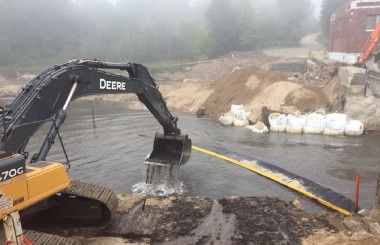
The best and final sediment management approach will likely include a mix of all these techniques: slow dewatering process, passive sediment management, and active sediment removal (Photo 12).
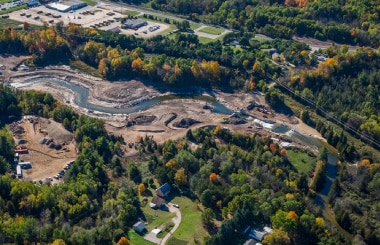
Restoring a Free Flowing River and Shorelines
After the water level starts dropping in the impoundment and a restored river channel is established, restoration work will begin. Sensitive areas, like existing infrastructure and wetlands, and public spaces will be a priority, with the goal of cultivating native grasses and plants before invasive species can populate the area. Some sections of the shoreline, like those on the outside bends of the river channel, will likely need to be fortified with tree root wads or boulders or a combination of the two. Later, native trees and shrubs may be planted to help hold the restored banks in place and improve habitat in the former impoundment.
After one or two growing seasons, the impoundment area begins to look quite green. After three or four, it can look natural and restored. After nine or ten years, it will be hard to tell there was ever a dam on the river.
Removing dams is an incredible way to restore a river, but it takes time and careful planning. Thankfully, for the Pen Dam removal project we’re working with a broad coalition of experts at federal and state regulatory agencies, local municipalities, academic institutions, and local nonprofit organizations. We’re excited to remove Pen Dam and restore this wonderful stretch of the Huron River.
by Guest blogger Janeen McDermott, PE, Senior Water Resources Engineer
 Janeen is a professional engineer licensed in the State of Michigan with over 12 years of water resources engineering experience. She has been engaged on over 20 local and regional dam removal and river restoration projects, many of which have included unique challenges related to water control/dewatering and sediment management. She holds a bachelor’s degree in environmental biology/Zoology from Michigan State University and a master’s degree in civil engineering from Wayne State University. Learn more about Janeen and her work at GEI Consultants.
Janeen is a professional engineer licensed in the State of Michigan with over 12 years of water resources engineering experience. She has been engaged on over 20 local and regional dam removal and river restoration projects, many of which have included unique challenges related to water control/dewatering and sediment management. She holds a bachelor’s degree in environmental biology/Zoology from Michigan State University and a master’s degree in civil engineering from Wayne State University. Learn more about Janeen and her work at GEI Consultants.




